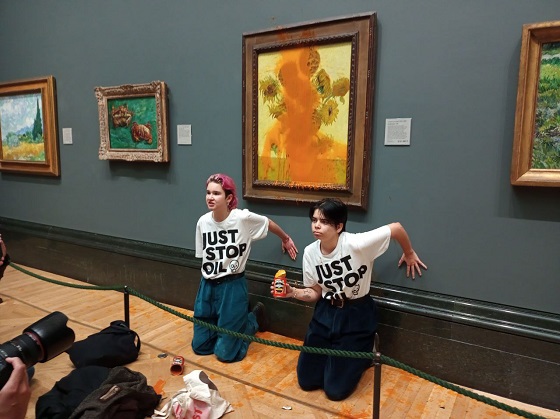Frontier Centre for Public Policy
ECO Extremism under reported in Canada

From the Frontier Centre for Public Policy
How many remember that shortly after the federal government introduced emergency legislation against convoy protesters there was a real terrorist attack on a Coastal GasLink pipeline worksite in British Columbia?
Ottawa and Canadian security agencies are ignoring a threat posed by eco-extremists motivated by self-righteous climate change alarmism.
How many remember that shortly after the federal government introduced emergency legislation against convoy protesters there was a real terrorist attack on a Coastal GasLink pipeline worksite in British Columbia?
About 20 masked assailants wielding axes entered a pipeline worksite and intimidated Coastal GasLink workers and caused millions of dollars of damage to equipment and vehicles.
While politicians and mainstream media were fixated on bouncy castles and hot tubs, armed fanatics were intimidating human beings with weapons and destroying energy infrastructure.
There was bare mention of it in the media. Politicians made cursory mention of it on social media. Unlike the convoy protests, there were no in-depth investigative pieces immediately after the eco-terrorist attacks against Costal GasLink.
Eventually some media picked up on this terror attack, but then downplayed it.
CBC’s Fifth Estate months later aired a program that attempted to disparage an RCMP unit meant to investigate extremist attacks on energy sector infrastructure. In a piece of over 40 minutes, less than a minute was devoted to exploring the February 2022 terror attack.
The CBC wrote more about the attack and did identify the culprits as anarchists but did not explore their ideological motivations. It was almost like they were just anarchists bent on destruction without a coherent ideology.
Perhaps if they would do a deep dive, they would discover that the anarchists believing they are helping an Indigenous resurgence have been raised on a diet of unscientific climate change alarmism.
I recently compiled research for a Frontier Centre study that looked at this looming eco-extremist threat.
Besides the Coastal GasLink attack, there are extremist groups like Just Stop Oil and Extinction Rebellion (in Canada). Traffic disruptions caused by Just Stop Oil have already led to bodily harm and unnecessary deaths in the UK where traffic mayhem ensued over a stunt on a bridge.
Canada has a serious blind spot when it comes to extremism associated with the far left. CSIS and Public Safety Canada are endlessly fixated on extremism associated loosely with the right, like Incels or anyone concerned about forced injections via vaccine mandates.
In Canada, the threat comes from various “Indigeno-anarchists” who believe they are supporting Indigenous people even as they attack energy projects that help First Nation communities. I discovered these extremists teach and recruit at our universities. Many professors are activists who normalize terrorism against the energy sector. Many were involved in the 2019-2020 Wet’suwet’en rail blockades that opposed Coastal GasLink.
Winnipeg activists were certainly involved. During the Wet’suwet’en blockades, they engaged in five major actions in Manitoba, from a demonstration outside an RCMP station to an action where “Indigenous warriors” blocked CN and CP rail tracks for several hours.
Calling themselves anarchists, they engaged in acts that could cause bodily harm and affect people’s ability to travel on passenger trains. Here is a document confirming they intended to commit “railroad sabotage.” Anarchists also make open mention of acts of sabotage and damage to drill sites associated with Coastal GasLink.
Central to the problem is problematic and torqued up climate change rhetoric that is causing unnecessary fear and anxiety within the public and is radicalizing people. If you believe the “earth is on fire” – which is a false belief held by many activists – some become radicalized to commit damage property and threaten lives.
Manitobans and Canadians must address the looming eco-terrorist threat before it’s too late.
Joseph Quesnel is a Senior Research Fellow with the Frontier Centre for Public Policy.
Business
Canada Urgently Needs A Watchdog For Government Waste

From the Frontier Centre for Public Policy
By Ian Madsen
From overstaffed departments to subsidy giveaways, Canadians are paying a high price for government excess
Not all the Trump administration’s policies are dubious. One is very good, in theory at least: the Department of Government Efficiency. While that term could be an oxymoron, like ‘political wisdom,’ if DOGE is useful, so may be a Canadian version.
DOGE aims to identify wasteful, duplicative, unnecessary or destructive government programs and replace outdated data systems. It also seeks to lower overall costs and ensure mechanisms are in place to evaluate proposed programs for effectiveness and value for money. This can, and usually does, involve eliminating some departments and, eventually, thousands of jobs. Some new roles within DOGE may need to become permanent.
The goal in the U.S. is to lower annual operating costs and ensure that the growth in government spending is lower than in revenues. Washington’s spending has exploded in recent years. The U.S. federal deficit exceeds six per cent of gross domestic product. According to the U.S. Treasury Department, annual debt service cost is escalating unsustainably.
Canada’s latest budget deficit of $61.9 billion in fiscal 2023–24 is about two per cent of GDP, which seems minor compared to our neighbour. However, it adds to the federal debt of $1.236 trillion, about 41 per cent of our approximate $3 trillion GDP. Ottawa’s public accounts show that expenses are 17.8 per cent of GDP, up from about 14 per cent just eight years ago. Interest on the escalating debt were 10.2 per cent of revenues in the most recent fiscal year, up from just five per cent a mere two years ago.
The Canadian Taxpayers Federation (CTF) continually identifies dubious or frivolous spending and outright waste or extravagance: “$30 billion in subsidies to multinational corporations like Honda, Volkswagen, Stellantis and Northvolt. Federal corporate subsidies totalled $11.2 billion in 2022 alone. Shutting down the federal government’s seven regional development agencies would save taxpayers an estimated $1.5 billion annually.”
The CTF also noted that Ottawa hired 108,000 more staff in the past eight years at an average annual cost of over $125,000. Hiring in line with population growth would have added only 35,500, saving about $9 billion annually. The scale of waste is staggering. Canada Post, the CBC and Via Rail lose, in total, over $5 billion a year. For reference, $1 billion would buy Toyota RAV4s for over 25,600 families.
Ottawa also duplicates provincial government functions, intruding on their constitutional authority. Shifting those programs to the provinces, in health, education, environment and welfare, could save many more billions of dollars per year. Bad infrastructure decisions lead to failures such as the $33.4 billion squandered on what should have been a relatively inexpensive expansion of the Trans Mountain pipeline—a case where hiring better staff could have saved money. Terrible federal IT systems, exemplified by the $4 billion Phoenix payroll horror, are another failure. The Green Slush Fund misallocated nearly $900 million.
Ominously, the fast-growing Old Age Supplement and Guaranteed Income Security programs are unfunded, unlike the Canada Pension Plan. Their costs are already roughly equal to the deficit and could become unsustainable.
Canada is sleepwalking toward financial perdition. A Canadian version of DOGE—Canada Accountability, Efficiency and Transparency Team, or CAETT—is vital. The Auditor General Office admirably identifies waste and bad performance, but is not proactive, nor does it have enforcement powers. There is currently no mechanism to evaluate or end unnecessary programs to ensure Canadians will have a prosperous and secure future. CAETT could fill that role.
Ian Madsen is the Senior Policy Analyst at the Frontier Centre for Public Policy.
Energy
Federal Clean Power Plan Risks Blackouts And Higher Bills

From the Frontier Centre for Public Policy
Ottawa’s Clean Electricity Regulations could derail Canada’s energy future. Here’s what we need to do
The federal government’s push to make Canada’s electricity system net-zero is running straight into reality—and it’s not pretty.
Through the Clean Electricity Regulations (CER), the government wants all provinces to eliminate greenhouse gas emissions from electricity generation by 2035. It is an ambitious goal, but one that ignores a basic fact: demand for electricity is exploding, and provinces are struggling to keep up.
New technologies like artificial intelligence are supercharging this demand. AI systems, including tools such as ChatGPT, rely on massive data centres—huge warehouses of computer servers that need constant cooling and enormous amounts of electricity to function. According to a recent Royal Bank of Canada report, if all proposed data centre projects in Canada move ahead, they would consume 14 per cent of the country’s entire electricity supply by 2030. That is roughly the same as projections in the United States, where data centres are expected to use up to 15 per cent of the national total.
This is a serious problem. Provinces such as Alberta and Saskatchewan have already raised the alarm, arguing that the federal regulations overstep Ottawa’s constitutional authority. Energy supply, like natural resources, has traditionally been under provincial control. Alberta and Ontario operate their own electricity markets to attract investment and ensure reliability. Federal regulations threaten to undermine these efforts, adding risk and driving up costs.
The situation is already tense. Alberta, for example, issued multiple grid alerts in 2024 due to shortages and market disruptions. The province is now looking at “behind-the-fence” power solutions, encouraging data centres to generate their own electricity to guarantee stability.
Canada was not always in this bind. For decades, we enjoyed an abundance of clean, affordable hydroelectric power. Provinces like Quebec, British Columbia, Manitoba and Newfoundland and Labrador built massive hydro projects starting in the 1960s, creating cheap power and even surpluses to export to U.S. markets. In 2022, for example, B.C. sent 74 per cent of its exported power to the U.S., while Quebec sent 63 per cent and Ontario an impressive 81 per cent, generating billions in revenue.
But that era is coming to an end. Most of the best sites for hydro dams have already been developed. New projects would require expensive, long-distance transmission lines to bring power from remote areas to the cities that need it. On top of that, growing environmental concerns make new dam construction an uphill battle.
The truth is, there is no quick fix. A 2025 study by the Fraser Institute paints a grim picture: to meet future electricity demand solely with solar power would require 1,680 years of construction. Wind power? About 1,150 years. Even hydro would take close to a millennium. Even if we combined these sources, we are still looking at more than 1,000 years to build enough capacity.
Meanwhile, federal projections estimate that Canada’s electricity demand will double by 2050.
Without significant policy changes, Canadians could soon face the worst of both worlds: soaring electricity bills and the threat of power shortages. Our economy could also suffer as companies and data centres look to other jurisdictions with more reliable power supplies.
So what should Canada do? Here are three practical steps:
- Scrap the Clean Electricity Regulations. Provinces like Alberta and Saskatchewan are already committed to reaching net-zero by 2050. Federal interference only creates unnecessary political battles and delays investments.
- Fast-track approvals for new interprovincial transmission lines. Today, building a new transmission line can take more than a decade. Speeding up this process would help provinces share power and avoid costly overbuilding of generation capacity.
- Launch a major low-interest loan program to build new power infrastructure. We need to dramatically expand our generation and transmission systems, including natural gas-fired plants, to meet future demand.
Canadians deserve a reliable, affordable and clean energy future. But we will not get there by ignoring the realities of rising demand and provincial responsibilities. It is time for the federal government to listen to the provinces, embrace practical solutions and avoid an avoidable crisis.
Otherwise, we are on track for blackouts, higher bills and missed economic opportunities.
Maureen McCall is an energy business analyst and Fellow at the Frontier Center for Public Policy. She writes on energy issues for EnergyNow and the BOE Report. She has 20 years of experience as a business analyst for national and international energy companies in Canada.
-

 2025 Federal Election21 hours ago
2025 Federal Election21 hours agoOttawa Confirms China interfering with 2025 federal election: Beijing Seeks to Block Joe Tay’s Election
-

 Energy2 days ago
Energy2 days agoIndigenous-led Projects Hold Key To Canada’s Energy Future
-

 Energy2 days ago
Energy2 days agoMany Canadians—and many Albertans—live in energy poverty
-

 Business2 days ago
Business2 days agoCanada Urgently Needs A Watchdog For Government Waste
-

 2025 Federal Election20 hours ago
2025 Federal Election20 hours agoHow Canada’s Mainstream Media Lost the Public Trust
-

 2025 Federal Election21 hours ago
2025 Federal Election21 hours agoReal Homes vs. Modular Shoeboxes: The Housing Battle Between Poilievre and Carney
-

 2025 Federal Election10 hours ago
2025 Federal Election10 hours agoBREAKING: THE FEDERAL BRIEF THAT SHOULD SINK CARNEY
-

 International2 days ago
International2 days agoPope Francis has died aged 88





